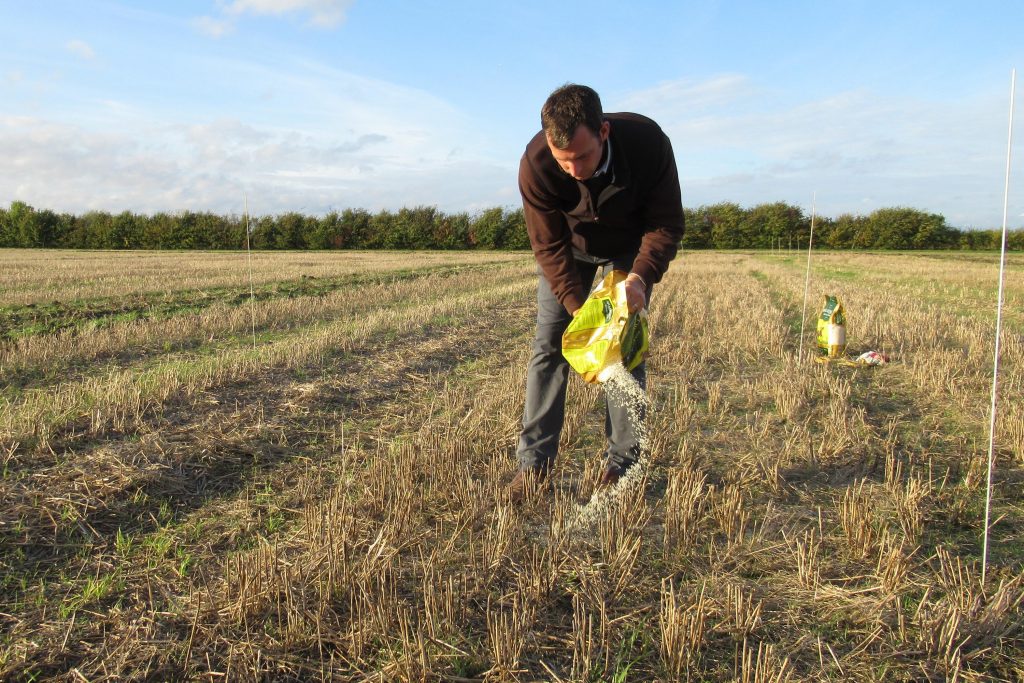Black-grass on the move
14th November 2017
New field trials using rice grains to mimic black-grass seeds have clearly demonstrated the implications of different cultivation techniques for integrated management of weed populations.

James Southgate spreading rice to simulate black-grass seed on stubble pre-cultivations.
New field trials using rice grains to mimic black-grass seeds have clearly demonstrated the implications of different cultivation techniques for integrated management of weed populations.
One of the key revelations of the work, on the Syngenta black-grass Focus Site at Barton near Cambridge, has been the valuable role of initial shallow stubble cultivations, reported James Southgate, Field Technical Manager responsible for the site.
“There has been advice to leave black-grass seeds on the surface to germinate post-harvest, and only cultivate in dry conditions to bring up moisture,” he said. “However, there’s been ample surface moisture this season and yet a 5cm shallow carrier cultivator pass produced a hugely advantageous weed seed chit.”
Mr Southgate highlighted the trial showed the single pass incorporated around half of black-grass seed into the soil germination zone and left 50% on the surface. “That would indicate that, where time and conditions allow, a second shallow cultivation pass would almost certainly be beneficial to incorporate seed and trigger a second flush.
“It’s quick, relatively low cost and to remove such a significant proportion of black-grass seed return at the first step of an ICM programme is a really positive start,” he enthused.
Plough pass
With the trial site’s field cultivations, Mr Southgate pointed out that the rice grain test demonstrated ploughing could effectively bury 98 to 99% of black-grass seed deep enough to prevent germination.
“It also demonstrated the importance of setting up the plough correctly and the skills of the operator – particularly to ensure the skimmers are adjusted to turn the surface layer into the furrow bottom, before the furrow turns over to bury the seed,” he advised.
Using a one pass min-till system to achieve a seedbed on the heavy-ground site this season, the rice grains showed that black-grass seeds were being distributed extremely evenly throughout the 14cm of cultivated profile.
“On easy soils, where you can achieve a fine level surface, black-grass may only be able to chit from 5cm or less – so two-thirds of seeds may be sufficiently buried with the min-till pass to prevent germination.
“But on a heavy soil with a cloddy surface, sufficient light may still be able to penetrate for black-grass to emerge from 8cm or more, which could result in up to 60% of seeds establishing.” Mr Southgate calculated that could mean close to 50% more black-grass seedlings to tackle with subsequent control options.
Direct solutions
Direct drilling, moving as little of the surface as possible, is designed to minimise further black-grass seeds germinating. However, the rice trials have shown that, even with an ultra-low disturbance drill, around 5% of black-grass seed would drop down the slot with the cereal seed.
“Given the conditions the seed is being placed into, you could anticipate high levels of germination and emergence – with direct competition to the emerging crop,” he said. “It’s certainly a very good result, but you would still be facing a large number of highly competitive plants needing further control.”
Mr Southgate added that further work and treatments on the cultivation trials’ plots through the season would evaluate the results of the different options, as part of developing overall cultural and herbicide integrated solutions for growers and agronomists.
